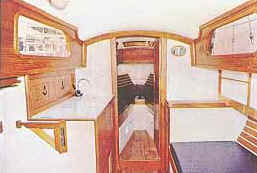A good construction adhesive is fine for interior marine use. I would go with the best exterior, premium grade you can find (which will cost you all of $2/tube). You will need to brace the pieces firmly in place while the adhesive cures, but I don't see why it would have any problem holding your moldings in place. I use this stuff regularly now, on interior pieces. It is very strong when cured. Since my nearest and favorite local hardware store is an Ace, I get the Ace brand premium exterior construction adhesive.
That said, if you have the ready supply of epoxy and want the assurance of a firm connection, there's no reason not to use epoxy to secure the moldings. Fortunately, wood glued to fiberglass with epoxy can be removed by splintering away the wood and then removing the remaining epoxy by sanding. Not fun, but do-able. If you were really removing this material at some point in the future, you wouldn't be worried about trashing it in the process. Frankly, any adhesive that actually worked well enough to secure these pieces successfully would not be a treat to remove down the road.
Don't epoxy the plywood to the cabin sides, though. This is most certainly a place for construction adhesive, and then just enough to secure the plywood well around the port openings and to prevent creaking and movement inside the capturing moldings.
dasein668 wrote:How about nice quality veneer. Nice and thin, should conform to the curves pretty well. Install with a quality contact cement.
The problem here is that the cabin sides are rough and uneven (Joe's boat is an early one), so veneer would never work over that sort of surface. If one wanted to veneer over one of the later boats' smooth liner, that would certainly be possible.
jhenson wrote:My preference would be furniture grade mahogany plywood. I was concerned that the deadlights might start to leak (like mine were before I removed them). I know that my soarce for mahogany plywood in this area carries nothing thinner than 1/4". It would be nice to find it in 1/8" for non-structural areas like lining bulkheads.
There is no reason to believe that your well-installed and well-maintained ports are going to leak without your noticing. Note that "well-maintained" means that the ports woudl be rebedded on a regular basis, or certainly at the first sign of the most minor leak. I think people tend to take far too much for granted that everything is going to leak. There is no "install and never look again" possible in any boat, ever. All installations require monitoring and rebedding at some point down the road. Always. There is no forever.
Moisture is a fact of life in the marine environment, but destruction of boat components by moisture is
not a guarantee...
if proper maintenance and inspection procedures are followed. Boats fall into ruin because of neglect, whether intended or not. Therefore, with a modicum of forethought, careful installation, and vigilent inspection and maintenance going forward, there is no reason to expect that your plywood veneers would be ruined.
1/4" plywood would be fine in this application. I myself don't know of an easy source for anything thinner, but it sounds good to recommend it nonetheless. If thinner could be obtained, it would be the ideal choice, but convenience would take precedence for sure.
One thing you could consider doing around your ports would be to cut the plywood openings a bit larger than the ports, leaving a space that you could fill with a thickened epoxy mixture to seal the plywood. This way, even leaks from the ports couldn't get directly into the plywood laminates. This wouldn't be a huge amount more work in the scheme of things, and would make for a higher-quality installation.
Again, future removal, if desired, would still be possible...but not without some work. I don't think anything that is easily removable (other than with only mechanical fasteners) would hold up under the constant movement of all parts of a boat in relation to one another. Failures of cheap adhesives are commonplace.






